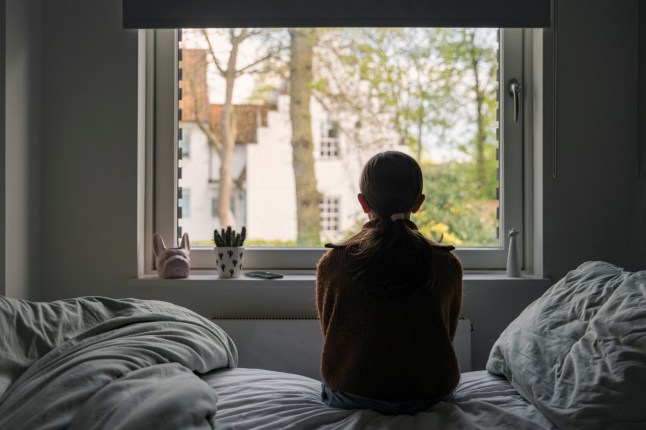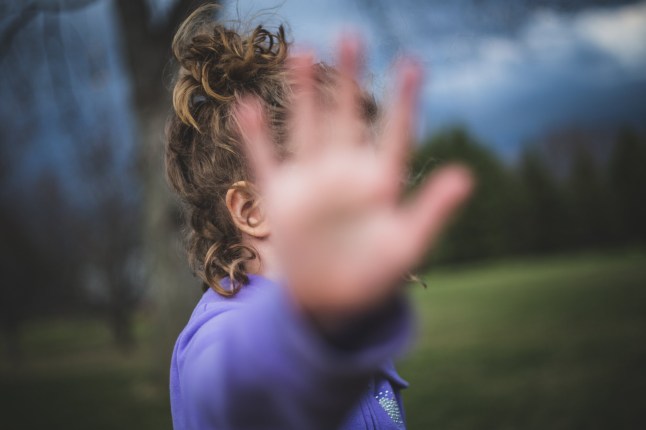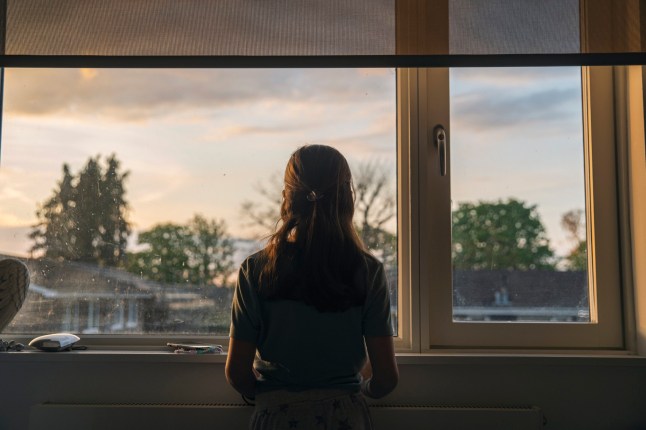Gaia Pope was just a teenager when she died. A ‘loving and intelligent’ girl,the 19-year-old enjoyed painting and drawing,and was described by friends as someone who ‘hated injustice’.
Gaia was also just a teenager when she was raped,groomed,and assaulted. Then 16,she became a victim of a huge injustice herself after local authorities missed more than 50 opportunities to support her.
Instead,the young woman left her aunt’s home in Swanage on November 7,2017,and vanished without a trace after calling her twin sister.
She had been suffering from PTSD and anxiety at the time,having just learned that her alleged rapist was released from prison.
11 days later,Gaia’s body was found in a quiet area on the Dorset coastline.
 Only 1.9% of the estimated 500,000 children abused each year receive help (Picture: Getty)Statistics around child sex abuse in the UK are staggering.Of an estimated 500,000 children abused each year,only 105,000 offences are recorded by police.Less than 2% of these young victims are seen by sexual assault referral centres in England and Wales and receive the help they need.Tony Kelly,a team manager for the National Society for the Prevention of Cruelty to Children based in Liverpool,tells Metro that there needs to be more funding for sexual abuse organisations to help counsel young victims.Currently,the NSPCC is able to offer young survivors of sexual abuse up to 38 sessions – one of the highest numbers offered by a free service.‘But when you’ve got 500,000 children a year suffering sexual abuse,whether directly or online,and you’ve only got 450 centres across the UK to provide support – it really,really isn’t enough,’ admits Tony. ‘And it’s a number that’s only gone up over the years.’
Only 1.9% of the estimated 500,000 children abused each year receive help (Picture: Getty)Statistics around child sex abuse in the UK are staggering.Of an estimated 500,000 children abused each year,only 105,000 offences are recorded by police.Less than 2% of these young victims are seen by sexual assault referral centres in England and Wales and receive the help they need.Tony Kelly,a team manager for the National Society for the Prevention of Cruelty to Children based in Liverpool,tells Metro that there needs to be more funding for sexual abuse organisations to help counsel young victims.Currently,the NSPCC is able to offer young survivors of sexual abuse up to 38 sessions – one of the highest numbers offered by a free service.‘But when you’ve got 500,000 children a year suffering sexual abuse,whether directly or online,and you’ve only got 450 centres across the UK to provide support – it really,really isn’t enough,’ admits Tony. ‘And it’s a number that’s only gone up over the years.’ The UK has an overarching issue of child sexual abuse (Picture: Getty)Echoing Tony’s comments,Simon Bailey, former National Police Chief for Child Protection and Chair of Embrace, tells Metro that child-on-child sexual violence has increased greatly over the last three years.In 2022,it accounted for 52% of the total number of reported child sex abuse cases. A year on,that figure increased to 55%.‘We should be asking why we are starting to see this become so prevalent. I don’t think we have come to terms with the scale of the trauma children are being exposed to through sexual abuse and abuse online,’ Simon explains.This is about challenging the logic of austerity.QuoteQuoteSimon believes that ‘not enough’ is being done to help the youngest victims of sexual violence recover and says more money needs to be invested in therapeutic services,like the NSPCC,which helps children recover from exposure to these heinous crimes.‘How do we do early preventative work to stop it happening in the first place?’ he asks.
The UK has an overarching issue of child sexual abuse (Picture: Getty)Echoing Tony’s comments,Simon Bailey, former National Police Chief for Child Protection and Chair of Embrace, tells Metro that child-on-child sexual violence has increased greatly over the last three years.In 2022,it accounted for 52% of the total number of reported child sex abuse cases. A year on,that figure increased to 55%.‘We should be asking why we are starting to see this become so prevalent. I don’t think we have come to terms with the scale of the trauma children are being exposed to through sexual abuse and abuse online,’ Simon explains.This is about challenging the logic of austerity.QuoteQuoteSimon believes that ‘not enough’ is being done to help the youngest victims of sexual violence recover and says more money needs to be invested in therapeutic services,like the NSPCC,which helps children recover from exposure to these heinous crimes.‘How do we do early preventative work to stop it happening in the first place?’ he asks. How can we address the sheer scale of the problem? (Picture: Getty)The question of how to fund therapy to support the youngest victims of sexual abuse is a difficult one. The CSA (Centre of Expertise on Child Sexual Abuse) identified only 450 services across the country – the vast majority of them not for profit and most relying on funding from local authorities,government or donations.Meanwhile,government services working to address this issue are overwhelmed. Tony and Susan both worked in local authorities and say the services were exhausted,underfunded and sometimes not properly trained.Tony explains that the ‘postcode lottery up and down the country when it comes to services’ shows we need more investment in therapeutic services.‘We need to be able to make sure that every child who suffered abuse has access to the right service. But it can also be professionals themselves,not knowing who to turn to as well,’ he says.
How can we address the sheer scale of the problem? (Picture: Getty)The question of how to fund therapy to support the youngest victims of sexual abuse is a difficult one. The CSA (Centre of Expertise on Child Sexual Abuse) identified only 450 services across the country – the vast majority of them not for profit and most relying on funding from local authorities,government or donations.Meanwhile,government services working to address this issue are overwhelmed. Tony and Susan both worked in local authorities and say the services were exhausted,underfunded and sometimes not properly trained.Tony explains that the ‘postcode lottery up and down the country when it comes to services’ shows we need more investment in therapeutic services.‘We need to be able to make sure that every child who suffered abuse has access to the right service. But it can also be professionals themselves,not knowing who to turn to as well,’ he says. Early intervention is key,but are authorities receiving the necessary training? (Picture: Getty)Meanwhile,Susan points out that funding for services to help victims of child sexual violence should not be considered as ‘funding’,but rather an investment.The ‘return’ won’t be seen right away,she adds,but if you don’t invest money in helping young people,in 20 or 30 years time,you end up with an ‘expensive addiction service’.‘You’ll see the health implications,the social housing implications,crime implications… It all adds up,’ Susan says.‘We have seen what investment can do. The five-year-old who couldn’t leave her mum’s side now can’t wait to go to after-school clubs,saying “Bye,mum!” and running off to join the other children. ‘The 13-year-old who was at risk of losing their place in school and their foster placement is now joining the youth participation group,which feeds back directly to parliament.‘Then there’s the 17-year-old who now has a really good relationship with their mum and her sister. At one point,they didn’t – now they’re making university applications,’ Susan smiles. ‘When the right service is provided and available,it makes a difference.’For Marienna Pope-Weidemann,to address the true scale of this crisis,we need to ‘challenge the logic of austerity’.‘The most frustrating thing is this widespread failure just to call a spade a spade and acknowledge how bad things are and how much really needs to change,’ she says.‘If Gaia had lived,I think she would have gone on to be a really powerful advocate for other young people like her and fight to get those services back and get them working for the community.’
Early intervention is key,but are authorities receiving the necessary training? (Picture: Getty)Meanwhile,Susan points out that funding for services to help victims of child sexual violence should not be considered as ‘funding’,but rather an investment.The ‘return’ won’t be seen right away,she adds,but if you don’t invest money in helping young people,in 20 or 30 years time,you end up with an ‘expensive addiction service’.‘You’ll see the health implications,the social housing implications,crime implications… It all adds up,’ Susan says.‘We have seen what investment can do. The five-year-old who couldn’t leave her mum’s side now can’t wait to go to after-school clubs,saying “Bye,mum!” and running off to join the other children. ‘The 13-year-old who was at risk of losing their place in school and their foster placement is now joining the youth participation group,which feeds back directly to parliament.‘Then there’s the 17-year-old who now has a really good relationship with their mum and her sister. At one point,they didn’t – now they’re making university applications,’ Susan smiles. ‘When the right service is provided and available,it makes a difference.’For Marienna Pope-Weidemann,to address the true scale of this crisis,we need to ‘challenge the logic of austerity’.‘The most frustrating thing is this widespread failure just to call a spade a spade and acknowledge how bad things are and how much really needs to change,’ she says.‘If Gaia had lived,I think she would have gone on to be a really powerful advocate for other young people like her and fight to get those services back and get them working for the community.’United News - unews.co.za